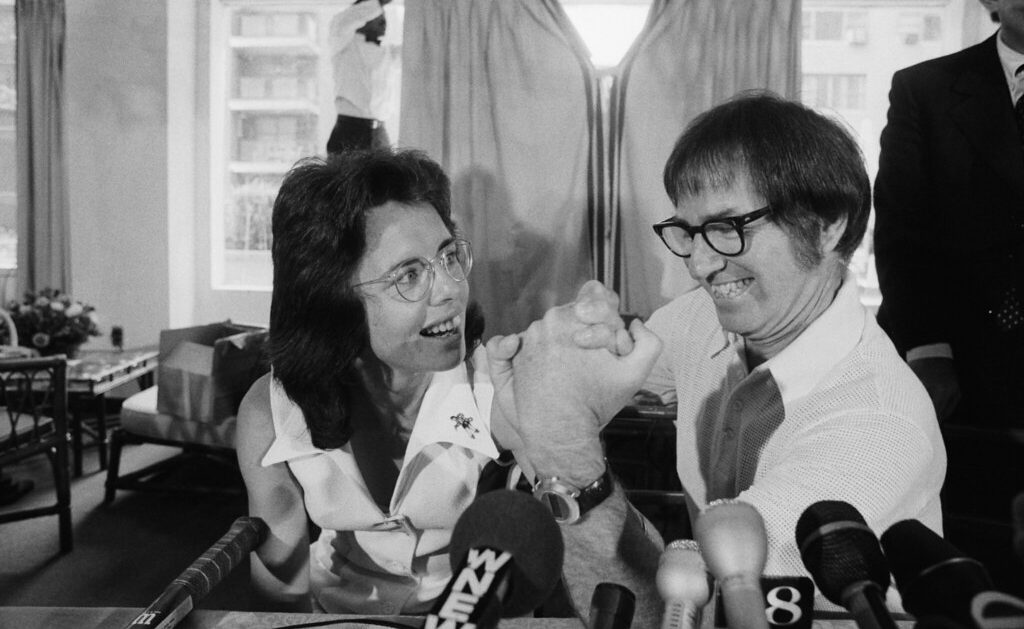The night of September 20, 1973 is considered one of the most influential nights in history for women in America. On this grand night, at the Houston Astrodome, the famous “Battle of the Sexes” took place, and to this day, it is considered one of the most-watched tennis matches of all time.1 Billie Jean King, a twenty-five year old female tennis champion, entered the stadium court accompanied by her gaudy male escorts, while Robert (Bobby) Larimore Riggs, a fifty-five year old former male tennis legend, entered with his scantily-dressed female entourage and a bedazzled jacket that said “Sugar Daddy” on the front of it. This tennis match wasn’t just a friendly exhibition event. King was fighting for women’s liberation while Riggs was fighting to fortify men’s superiority… and everyone knew it.

Riggs had publicly entertained the notion that men are simply better than women, especially when it comes to athletics. He had recently played and soundly beaten Margaret Court, another outstanding women’s tennis player, which came to be known as the “Mother’s Day Massacre,” but his mission was to prove that he could beat one of the very best female tennis players in the world: Billie Jean King.2 He wanted nothing more than for everyone to see that men receive more prize money than women in professional tennis because they are more skilled. King accepted this challenge with gusto. For months leading up to the match, she continued to train hard despite the constant theatrics and press presence she had to allow, because she knew that nobody else would have this kind of opportunity again. King had the platform to prove, on a wide scale, that women are more than capable of competing at the highest level like men do–and that they deserve equal pay for it. She piled the weight of every female’s hopes and dreams on her back, and nobody knew at the time how momentous this one match would be in the decades to come.
Billie Jean King was an early, outspoken feminist who agreed with the ideals embodied in “second wave feminism.”3 Second wave feminism is the movement for social change that encourages equality between men and women and extends far beyond women’s suffrage, which is considered the first wave of feminism. Major issues, such as equal treatment in the workplace, equal pay, a woman’s right to choose what to do with her body, and a push for the recognition of these concepts in government and politics, are included in second wave feminism. This feminist era began with a report written by the First Lady Eleanor Roosevelt’s Committee on the Status of Women in 1963. The report encouraged everyone to recognize that women weren’t being treated fairly or equally at work, and it pushed for maternity leave, suitable pay, and reasonably-priced childcare. On June 10, 1963, Congress passed the Equal Pay Act, which deemed it illegal to pay a woman less than a man for the same quality of work. At this point in time, too many women were trapped in their stereotypical female jobs and activities, such as being a mother, a secretary, a nurse. They hadn’t been given the opportunity for a major push to step out of the traditional realm, which is what second wave feminism was fighting for. The Civil Rights Act of 1964 declared that discrimination due to gender or race was illegal in the workplace, and although that helped decrease discrimination, it didn’t fully extend into Americans’ homes where women were expected to care for the children and clean the house unconditionally. However, soon after the Civil Rights Act of 1964 passed, the Equal Employment Opportunity Commission (EEOC) was imposed to investigate cases where women were not being treated fairly according to Title VII of the Civil Rights Act of 1964. This ensured that women were given equal opportunities, therefore enabling them to venture out from their traditional female roles to become doctors, engineers, or even business owners. Schools couldn’t deny them entry simply because they were women since doing so would violate the law. Betty Friedan, author of The Feminine Mystique (an inspiring book that encouraged women to dream for more freedom in their lives), was viewed as the founder of second wave feminism. Friedan had felt that the government failed to enforce Title VII of the Civil Rights Act of 1964, so she formed the National Organization of Women (NOW), an organization dedicated to the “full equality of women.”4 Another feminist icon during this time was Gloria Steinem, a woman that encouraged all women to become involved in this feminist movement by travelling all around the United States, bringing women together and assuring everyone that this movement was not simply meant for wealthy white women. She inspired people by speaking on the Senate floor in favor of the Equal Rights Amendment and by publishing a magazine called “Ms.” which quickly became a place for feminists to stay up to date on the progress of major issues. Billie Jean King joined her effort to pressure the Senate into passing the Equal Rights Amendment (ERA) in 1972, just one year before she was to play Bobby Riggs.5

48 million Americans were watching this famous match, either at the Houston Astrodome or on their televisions at home. The crowd was figuratively divided between most men and women. The women supported Billie Jean King and viewed her as their personal representative for equal rights, both in athletics and in general society. The men cheered for Bobby Riggs, knowing that his main role was to squash the idea that women have the capability of being a man’s equal, especially in sports. The prize money of the match was $100,000, but that was nothing compared to what was on the line in reality.6
The match finally began. Riggs wore his demeaning “Sugar Daddy” jacket for the first three games of the first set, having believed that it would be a walk in the park like his match with Margaret Court was. King played her usual tennis game, the one that had earned her five Wimbledon titles, and found herself putting away volleys at the net repeatedly, thus forcing Riggs to either sprint all over the court or simply lose the point. Her plan was to tire out the fifty-five year old player, and she succeeded. Riggs removed his jacket quickly after realizing that it would take extensive effort to defeat King. He wasn’t expecting her to be such a tough competitor; Riggs was a firm believer in everything he told the press about women being unable to hold their own on a tennis court with a man. After running Riggs all over the court, King won the first set 6-4, and the women watching were given a small victory with much more to come.7
The United States was engrossed with the King vs. Riggs match, and the politics of it also helped bring up the significance of Title IX. Title IX was a part of the U.S. Education Amendments of 1972 that focused on gender discrimination in education. The law stated that “No person in the United States shall, on the basis of sex… be subjected to discrimination under any education program or activity receiving Federal financial assistance.”8 Under this law, it was illegal to discriminate against women or girls in any school that received federal funding from the United States government. There are many examples of female collegiate athletes that were discriminated against due to their seemingly inferior gender. In the 1960s, before Title IX was a law, the rules for women’s basketball differed significantly from men’s basketball because people thought that women’s stamina wasn’t impressive enough to handle a full-court game. The women were also required to pass the ball after dribbling it only three times. The first normal, full-court game of basketball that women were able to play occurred in 1969. In the late 1960s, a female student named Kathrine Switzer at New York’s Syracuse University unofficially trained with the school’s male cross-country team before being told by the coach that women are incapable of running a marathon. Determined to prove exactly what women are capable of, Switzer ran 31 miles in practice (5 miles longer than a marathon), and went on to compete and finish the Boston Marathon in 1967. Even after Title IX was passed, women still had a difficult time receiving equal treatment because their facilities were lacking compared to the men’s. In 1975, the successful women’s rowing team was made fun of for using the weight room, and they had to use boats that were inferior to the men’s boats. After training in the freezing cold waters, the female rowers were forced to load up on the team’s bus and wait while the men were allowed to relax in the hot showers in the locker room by the river before joining the women on the bus. Under no circumstances were the women allowed to use the men’s showers, even when the men weren’t training with them. March 3, 1976 marks the day when the female rowers had decided they had had enough of this despicable mistreatment. They went to the director of physical education for Yale University and stripped off their shirts to show the letters they had written on themselves that spelled out “Title IX” to protest the difference in funding between the men’s facilities and their own. One of the school reporters documented the entire scene, and the story made it all the way to the New York Times. The Yale students began to realize how unacceptable it was for the women’s rowing team to be treated like second-rate citizens even though they were amazingly talented and hardworking. These young women were competing at an incredibly high level at one of the most prestigious universities in the country, and yet they weren’t allowed to shower. All over the country, people’s attitudes began to positively shift regarding Title IX.9
Although King claimed that granting equality to female athletes was simply “the right thing to do,” with Title IX (which she firmly supported), equality became a law.10 As colleges were required to give more funding to females’ sports, more and more females got involved with athletics and began training hard to be accepted onto collegiate sports teams. The number of female athletes participating in U.S. collegiate-level sports grew from 16,000 in 1966 to 64,000 in 1976, and by 1980, an inspiring figure of 100,000 female athletes were competing for college sports teams all over the country. This law was further enforced when Congress passed the Civil Rights Restoration Act that stated that all athletic programs had to abide by the rules of the Title IX law whether they received federal funding from the U.S. government or not. The legal aspect of Title IX made it more normal for women to compete at the collegiate level, thus helping to further change people’s attitudes regarding women playing high-level and high-intensity sports. The idea of women’s athletics began to evolve even more after Ann Meyers received the first full athletic scholarship to play basketball for the University of California, Los Angeles in 1974. She went on to become the first woman to sign a contract with the National Basketball Association (NBA) until she finally ended up as a successful sports commentator. She was given incredible opportunities in life simply because she was recognized for her talent and provided the accommodations necessary to kindle and enhance her athletic abilities, all due to the passage of Title IX. When all women’s sports started receiving adequate funding, more women were encouraged to compete at the collegiate level.11
After having won the first set 6-4, Billie Jean King knew she couldn’t take her foot off the gas pedal. Women everywhere were counting on her to clench this match, and she wasn’t going to let them down after she had come so far. Billie Jean continued with the game plan she had played in the first set: relying on her strong backhand and serve-and-volley game to tire out her older counterpart. At this point, Riggs was no longer making jokes or trying to entertain the crowd with his degrading comments and gestures; he was simply trying to stay in the match. With a little less effort than was necessary in the first set, King won the second set 6-3. She had to stay focused in order to keep herself mentally in the match; it’s incredibly easy for tennis players to look ahead so far that they feel as though they have already won the match, even when it isn’t over yet. Being the true champion and icon that she is, Billie Jean played with the same intensity in the third set that she had had in the first two sets. She finally won the last set 6-3, thus winning the entire match and proving to Bobby Riggs as well as everyone watching that women are just as capable as men.12
This major victory brought many great things for Billie Jean King’s future as well as for the future of all women wanting to experience the freedom of pursuing whatever they want in life without the constricting limitations brought about by gender. Even though there were still more struggles to come in the future after this momentous occasion took place, this match gave people an inspiring event to rally behind. In the late 1970s, Billie Jean retired from her constant tennis schedule and promised that she would dedicate a few months each year to her tennis so that she could play World Team Tennis, an event that many tennis fans love to watch. Three decades after the famous tennis match, she was interviewed once again regarding the historical significance of the day everyone watched when she beat Bobby Riggs, despite the mental pressures of the event. She recalled that “[her] job in the match, [which she] remember[s] being very clear, was to change the hearts and minds of people to match the legislation of Title IX and what [they] were trying to do with the women’s movement.” 13 Her goal had been to use the match as a pathway to equality for everyone, whether it be in sports, the workplace, or in their social lives.

The United States Tennis Association (USTA) honored Billie Jean King’s major accomplishment by building the Billie Jean King National Tennis Center in Queens, New York City in 1978.14 Since then, the annual US Open Grand Slam tennis tournament has been played at her tennis center, reminding everyone that Billie Jean King’s courage, determination, and skill allowed her to help women all over the country overcome the social stigma attached to women in general. She inspired them to go after their dreams and face opposition, and she paved a path for young girls everywhere to ensure that when they all face their own personal Bobby Riggs, the last thing they’ll do is step down.
- Susan Ware, Game, Set, Match: Billie Jean King and the Revolution in Women’s Sports (North Carolina: The University of North Carolina Press, 2011), 1. ↵
- Jane Summer, Billie Jean King (Michigan: Gale, 2004), 24. ↵
- Feminist Philosophies A-Z, 2007, s.v. “Second Wave Feminism,” by Nancy McHugh. ↵
- Feminist Philosophies A-Z, 2007, s.v. “Second Wave Feminism,” by Nancy McHugh. ↵
- The Senate approved the ERA in March 1972, sending it to the fifty states for their ratification. It failed to receive the necessary two-thirds states’ ratification to become a constitutional amendment by its sunset date of March 22, 1979. ↵
- Susan Ware, Game, Set, Match: Billie Jean King and the Revolution in Women’s Sports (North Carolina: The University of North Carolina Press, 2011), 1. ↵
- Susan Ware, Game, Set, Match: Billie Jean King and the Revolution in Women’s Sports (North Carolina: The University of North Carolina Press, 2011) 2. ↵
- Encyclopedia of Diversity in Education, 2012, s.v. “Title IX of the Education Amendments of 1972,” by Catherine F. Pieronek. ↵
- Sue Bradford Edwards, Women in Sports (Minnesota: Essential Library, 2016), 43, 52. ↵
- Sue Bradford Edwards, Women in Sports (Minnesota: Essential Library, 2016), 42. ↵
- Sue Bradford Edwards, Women in Sports (Minnesota: Essential Library, 2016) 46. ↵
- Susan Ware, Game, Set, Match: Billie Jean King and the Revolution in Women’s Sports (North Carolina: The University of North Carolina Press, 2011), 2. ↵
- Susan Ware, Game, Set, Match: Billie Jean King and the Revolution in Women’s Sports (North Carolina: The University of North Carolina Press, 2011), 43. ↵
- Susan Ware, Game, Set, Match: Billie Jean King and the Revolution in Women’s Sports (North Carolina: The University of North Carolina Press, 2011), 44. ↵




33 comments
Isabel Soto
This article discusses a topic that is still very important as of now. Although there were certain acts passed for the equality of women, if we look closely we will notice that even now, there is still inequality between genders. When talking about sports, many women athletes won’t get paid the same amount as men athletes, and many women athletes also won’t get the same recognition as men. I love that i got to read this article because it thought me more than i need to know.
D'vaughn Duran
Great article with an amazing topic! I didn’t know much coming into reading this, but Billy Jean and how she was an inspiration. With Billy Jean motivates all women in this sport in a global sense. Shows how passionate she was and her having a platform used its fight for equality! I thought this was a great topic with not knowing anything coming into this.
Victoria Castillo
Great article! I didn’t know who Billie Jean King was before, so learning that she was practically the representative for equal rights of both athletics and women during this time is quite phenomenal. I also didn’t realize just how different sports were for women during the 1970s were because of the discriminations pushed against them. I am glad though that with King’s win against Riggs it brought better inspirations for women and more opportunities even though there was still a lot of discrimination.
Madison Magaro
Billy Jean King was not only an amazing tennis player, but also was a great activist fighting for equality in sports at any level. The match between King and Riggs helped prove that women can be just as good as men if not better. This article did a great job at giving details on the feminist movement. Overall the author did a great job writing this article and it was a great read.
Danielle Rangel
This article brings such an empowering and pivotal moment to light. I never knew that a single tennis match could result in the improvement of women’s sports. I also didn’t know how insane women’s sports were back then. This article educated me on an incredible and determined woman who changed history. This article was one of the most entertaining articles I have read!
Maggie Trujillo
I have heard about the tennis match between King and Riggs, but didn’t realize the importance behind it. This article was great to articulate and represent what King did that day. As a former high school student athlete, I appreciate what Title IV brings females competing in sports. I am glad that the Yale rowers stood up for themselves and demanded better than what they were getting. I am also glad for women like King who went on the national stage and proved that women were just as good as men playing at any level.
Danielle Sanchez
This article was well written about an impactful event that shaped history. On the night of September 20th, 1973 Battle of the Sexes took place at the Houston Astrodome. This was the most-watched tennis match of all time. Billie Jean King, a female tennis champion, would go up against Robert (Bobby) Larimore Riggs. Billie Jean King would enter with her gaudy male escorts whilst Bobby would enter with a female entourage and a bedazzled jacket that said, “Sugar Daddy” on the front of it. This set the tone for a not so friendly tennis match.
Marissa Rendon
This was an amazing article to read and an excellent read about King. King used her voice to fight for the opportunities women deserve. King displayed an excellent example of fighting for what you deserve. Im glad she has given the opportunity for women to get equal rights when it comes to sports. No one should be held back from what they want to do because of their gender. Gender should never define what you can or cannot do.
Andrea Tapia
I really enjoyed this article and hearing about the influential woman herself Billy Jean King. She used her voice to fight for Women’s rights and show the world that women can do as much as men can. She was not only able to guide women but men as well to inspire the fight for equality and justice that women deserved. I had always believed I could do more if I put my mind to it so women like King showed me that nothing is impossible. King has now changed the way we live for the better by allowing women equal opportunities in sports, jobs, and so much more. She has so much respect from us because she did not just win a match, but she build a community for women athletes back then and today to be better. She wasn’t just a tennis player, but someone who believed in millions of women.
Olivia Gray
Wow, this is such a great article and I really enjoyed reading it. The legacy of Billie Jean King is truly inspiring. She is a reminder that individuals can make a real difference in the fight for equal rights. Her story is an example of what can be achieved when people stand up and fight for what they believe in. She is an example of the power of determination and hard work.Billie Jean King is a remarkable figure in the history of women’s athletics